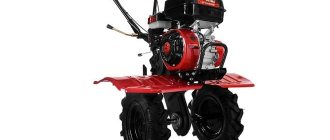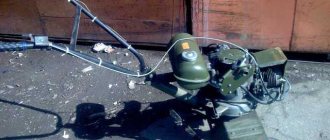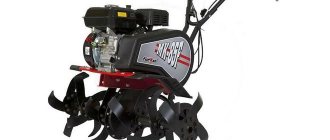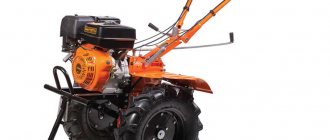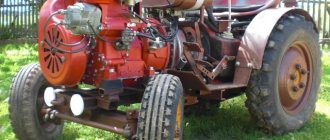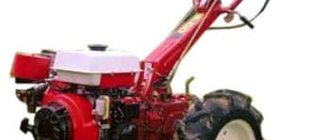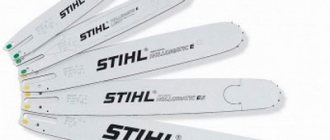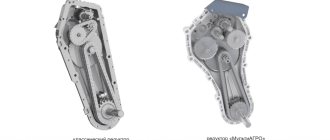Heap cleaner of the self-moving model OVS - 25 - this modern mechanical device is primarily intended for primary and preliminary cleaning of grain heaps immediately coming from the field of all cereal crops, leguminous crops, cereals, corn, sorghum, sunflower from various impurities on open currents in absolutely all agricultural lands of the country.
The device also performs preliminary cleaning of sugar beet seeds and heaps of castor beans using special devices on separate orders for an additional fee. The machine can be used for loading and shoveling grain in heaps no more than 4.5 m wide. The machine is self-moving.
Photo of heap cleaner OVS-25
Design of OVS-25
The machine package includes:
- loading conveyor
- receiving chamber with power supply device
- separating system with pneumatic movement
- sieve mills
- waste feed auger
- transmission systems
- other auxiliary mechanisms
All components of the unit are mounted on a welded metal frame equipped with a propulsion device with the ability to move independently. The working mechanisms are driven by 4 electric motors. Motors intended for separators have a power of 4 kW, for the unloader and loader of grain or heap - 2 engines of 2 kW each, and for moving the unit - 1.1 kW.
A heap of agricultural plants is cleared at a speed of 9.15 m/h. The speed of movement within the current is 0.25 km/h. Independent movement outside of electrical work is strictly prohibited.
Specifications
| Structural weight (minimum/maximum configuration) | 1,840/1,950 kg |
| Performance | 12-25 t/hour depending on the cleaning mode, humidity and impurity content |
| Total power of electric motors | 9.2 kW |
| Length | 4,730 mm |
| Width | 5 460 mm |
| Height | 3 310 mm |
| Travel speed during preliminary and primary grain cleaning | 12 and 3 m/hour respectively |
| Maximum transport speed | 36 m/hour |
The service life declared by the manufacturer is 9 years, when using the grain cleaner on average up to 260 hours annually. The equipment is serviced by one operator.
Design and adjustments of ovs 25
Cleaning a heap of grain material on an OVS-25 winnowing machine consists of several stages:
- Scraper grips, while the machine moves along the coil, supply the source material to the loader pipe.
- The heap rises through the lifting pipe into the receiving compartment.
- A special receiving chamber mechanism evenly distributes the material across the entire width.
- The distributor divides the mass into equal parts and sends them into two pneumatic separating channels.
- In the pneumatic separator, light impurities are released and carried away by the air flow.
- Heavy, large impurities fall into the sediment chamber, small ones are collected in an inertial dust separator.
- After cleaning from impurities in the pneumatic separating channels, the grain flows along two guides to two identical devices, sieve mills: upper and lower.
The cell sizes of the sieves are selected based on the division of grain into two fractions of equal mass, called: exit - grain plus large impurities and passage - grain plus small impurities. Dividing the total mass of the starting material into fractions of different sizes significantly increases the productivity of the sieve system. Coming off the B2 sieve, where large impurities are separated, it enters a smaller B1 sieve to separate small debris fractions, after which the grain is sifted on sieves B and D, with identical cells and installed one after the other.
The passage after the B1 sieves is cleaned grain. On sieves B and D, small defective grains are separated: broken grain, undersowing, puny, broken grain. The exit from the sieve G is also purified grain. Light impurities are blown to the side using a pneumatic conveyor; the remaining screened impurities are removed through the feed waste auger and stored in a feed waste bunker. The cleaned grain is sent to the receiver, from where it is fed by an auger into the lower head of the loading conveyor.
Technological diagram of the operation of sieves B1. B2, C and D
Adjusting the grain cleaner OVS-25
The power of the air flow is regulated based on two main parameters:
- the most complete separation of the wheat from the chaff
- the smallest amount of grain carried away with feed waste
The optimal air flow rate is considered to be one at which no more than 0.05% of the grain ends up in waste.
The operating speed of movement and suspension of movement are selected so that at maximum loading of the sieve mills, minimal excess grain is retained in the receiving chamber.
Even more information!
Application
OVS-25 is suitable for farms growing any grain crops:
- sunflower;
- corn;
- legumes;
- wheat
The use of such machines becomes the optimal solution for pre-processing grain from foreign impurities, making it suitable for transportation to storage sites or further processing. An important factor is the installation of the grain cleaner on a self-propelled chassis, which makes the use of the equipment more practical and cost-effective.
Selection of sieves for OVS-25
In order for the grain cleaner to perform its tasks more efficiently, an accurate selection of sieves is necessary, depending on the grain size of the crop being processed.
Recommendations for selecting sieves:
- Sieve B2 should allow all the grain to pass through, separating large impurities into a collection.
- Sieve B1 divides the processed mass into two equal parts.
- Sieves B and D, thanks to holes smaller than the size of full grains, allow only broken, defective grains and fine inclusions to pass through.
Rules for selecting sieves for grain cleaners
There are two concepts. Drainage is when grain and debris roll off the sieve without falling into the holes and passage . During the passage, legumes that have fallen into the sieve holes are taken into account.
We select B1 and B2
First of all, we need to determine the working surface of the sieve. To do this, choose the side with the smoothest side. This is usually the side where the mesh size of the sieve itself is stamped. It is this side that is installed on OBC 25. The smoothest side should face up.
Next, you need to place the sieve on a flat surface and pour several handfuls of grain onto it that will be cleaned. Then we lift one edge of the sieve, simulating the tilt of the machine itself, and with blows of the second palm we imitate the operation of the grain cleaner.
Do not rub the grain into the sieve under any circumstances, otherwise you will not be able to assess the optimal sizes.
Now it's time to evaluate the results of our test. If the sieve remains: garbage, clods of earth and a small amount of tested grain, then the sieve has been selected optimally.
Selecting B and D
Now it’s time to select smaller sieves. Here the procedure is the same as in the first case, with the only difference that now we are testing the grain that has passed through the sieve, that is, the passage.
I would like to note that the selection of sieves should be carried out in the sequence in which they will be installed on the machine itself and do not forget about the working surfaces. It is also necessary to remember that sieves must be installed in cassettes without gaps.
After installing all sieves, according to the instructions, it is necessary to do a test cleaning. If there is an excess of large impurities in the purified grain, replace B1 and B2 with smaller ones. If there are many small fractions left, replace B and D with larger ones. Also, larger sieves B and D are used for screening out seed material.
Number of sieves: 8
In the photo: sieves for oats 25
Pressing the brushes against the sieve should ensure that the bristles penetrate through the cells 1-2 mm above the surface. Accurate adjustment of the tension of the belts and chains of all transmission mechanisms is also important. When changing from one crop to another, the machine must be thoroughly cleaned of seed residues.
Sieve sizes
The overall dimensions of sieves for different machines are somewhat different, but in fairness it is worth noting that sieves of such models as: SM-4, OVP-20A, ZNV-10, ZNV-20, SVU-5A, ZAV10.30.000, ZD10.000, OVB , SPS-5 are also suitable for OVS 25. Size on the sides: 990 x 790.
Manufacturers
It is noteworthy that the OVS-25 is not the own development of any enterprise. This is the result of the massive introduction of flow technologies for grain processing, which took place in the 60s of the last century. Therefore, this modification of a self-propelled grain cleaning machine is produced by several Russian enterprises. Each manufacturer makes its own design decisions, but the general concept and principle of operation of the equipment remains unchanged.
Among the domestic manufacturers specializing in the production of OVS-25, the following companies can be distinguished:
- Voronezhselmash . This is one of the oldest and largest factories in Russia for the production of grain processing and elevator equipment. The company has been working in this field for more than 90 years, and throughout its history it has never deviated from its chosen specialization, constantly introducing innovative technologies.
- Plotava . The company operates in Barnaul, developing grain cleaning complexes. In addition to manufacturing, the manufacturer provides installation and maintenance services for equipment, and supplies spare parts and components.
- AgroStroy . The production lines of this enterprise are located in Voronezh, the main specialization is the development of agricultural machinery for various purposes.
Separately, we can highlight the company AgroTechMash, which has been operating on the market since 2014, but is already considered one of the leaders in the production of grain dryers and grain cleaning machines.
The advantages of a self-propelled heap cleaner from the ATM company include the following points:
- A lightweight version of the sieve mill. Thanks to this solution, the loads on the electric drive and clamps are more rationally distributed, which significantly increases the service life of the equipment.
- Patented lubrication system for bearings and rubbing parts. Grease dispensers significantly simplify the maintenance procedure; bearing housings have an increased safety margin.
- Frequency converter integrated into the gear motor housing. This element allows you to adjust the transport speed from the main control panel.
- Modified wheelbase. Making a number of changes to the standard design helped to achieve a softer and smoother ride, which has a positive effect on the quality of primary grain processing.
In addition, AgroTechMash participates in the state program to assist the development of the agricultural industry, so the company offers to buy grain cleaners at a reduced price.
Preparing for work
The preparatory process begins with removing the sieve cassette and installing feeders, conveyor and screw assembly extensions. Next, you should put the belts on the pulleys of the main working units. When putting on the belts, it is very important to release the tensioner. When the belts are secured, begin to put the chains on the chassis and tension the counter-drive belt. The optimal tension is if the belt can be moved from a straight line by forty to seventy millimeters for every meter of belt length. A stronger tension will lead to rapid wear of the belt, and a weaker tension will increase the belt creep onto the sprocket. The last step is connecting the device to the electrical network.
Advantages of a grain cleaning machine
The main advantage of the apparatus for cleaning grain raw materials is its mobility. The OVS-25 grain cleaning machine is capable of easily moving across virgin soil or other territory without interrupting the work process and using traction equipment.
This operating principle allows you to save time, financial resources and fuel. Other advantages of the device include:
Heap cleaner OVS-25
- efficiency;
- does not require the use of a conveyor for unloading processed raw materials, which significantly saves money;
- The device allows you to not only clean grain, but also dry it;
- high-quality processing of cereal crops;
- the purification of raw materials is carried out in several stages, which allows you to achieve better results;
- ease of maintenance and management OBC-25
- any foreign inclusions in the raw material are unloaded automatically;
- During the cleaning process, the grain is practically not damaged, which does not impair its quality;
- only one operator is required to operate the machine;
- the presence of a scraper cleaning mechanism;
- the unit is able to work without any difficulties in any conditions, regardless of existing weather conditions.
